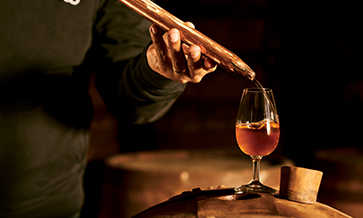We’ve heard of wines from grapes, even those made from kiwi fruit. But wines from the luscious chikoo and mango? Or from strawberry, starfruit and pineapple? Since January 2016, Hill Zill Wines – located in the horticultural belt in the Konkan, north of Mumbai – has been making wines from these fruits; and winning awards too! Hill Zill Wines’ Founder-Director, Priyanka Save, lets us in on how it is done, what her challenges were, and how the Fruzzanté brand of wines is expanding across states.
The Hill Zill winery is located in the quaint settings of a small coastal town of Bordi, about 150 km north of Mumbai. It is a dream come true for Priyanka and the co-founder, Nagesh Pai, to set up and successfully run the world’s first alcoholic beverage from chikoo (sapota).
Working with fruits other than grapes was a challenge when they initially began the winery. They visited several wineries in India and abroad to understand the production process and critically analysed their observations, including the juice extraction for various fruits. Both are engineering (mechanical) graduates, which helped them understand processes and technology better.
Assisting in realising their dream was the consultant, Mr. Dominic Rivard, a distinguished fruit wine and cider maker in North America. His expertise and over 20 years of experience in wine making was instrumental in achieving the desired results.
In fact, the chikoo wine from Fruzzanté went on to win a silver medal at ‘Drink Outside the Grape Challenge’ in the US in 2017, competing alongside 145 other wines and ciders!
Today, Fruzzanté is a cider-style sparkling alcoholic beverage currently available in the Maharashtra and Goa markets. The winery has an online carbonation system which carbonates the finished product and bottles the fizzy drink. It also produces the premium honey dessert mead, Arkä.
Tough going
The choice of chikoo was natural, considering that the coastal belt is home to vast tracts of orchards; “but it was probably the toughest of all fruits we have dealt with so far,” recalls Priyanka.
Unlike grapes, which ripen naturally on the vine and are harvested when the desired ripeness is achieved, ripening chikoo evenly and in large quantities was the main challenge.
“We worked with a local cold storage manufacturer who helped us create a fruit conditioning chamber that maintains both temperature as well as adequate fresh air inside it,” Priyanka says.
The chamber controls CO2 levels and ensures even ripening of fruits. Hill Zill Winery has an installed capacity of 12 tonnes of fruit at a time. It takes about 96 hours for chikoo to ripen well over 80%.
Thereafter the fruit is squashed in a mill which has pedals (instead of blades) to ensure the seed remains intact. The squashed fruit is then pressed in a hydraulic basket press to extract its juice. The benefit of uniform ripening can be seen in the better quality of juice, resulting in a quality product.
For extraction of fruit juice a hydraulic fruit press, which was originally used to cold press fruits for cider making, was imported. Cold-pressed fruits ensure quality juice resulting in quality product.
But different fruits have different pressure requirements for effective juice extraction – certain fruits (grapes) are delicate or have undesirable flavonoids from their peel (orange). Hence, different fruits need different combinations of processes such as pulping, crushing and pressing. Chikoo has to undergo all these processes.
Understanding fruits
Fruits are broadly classified into berries, stone fruits, citrus, melons, tropical, etc. The process of juice/ pulp extraction is different for different fruits. A de-stoner is required for mango pulp extraction, whereas strawberry needs to be crushed and pressed for juice.
The study of juice extraction had to be thoroughly done before designing the plant and installing the machinery. The study involved understanding the nature of fruits to be processed and effective means of extracting healthy “must” that is conducive to the process of fermentation.
“When working with different fruits we come across different types of acids as well as sugar combinations. Determining all parameter in terms of chemical as well as micro-biological analysis is important,” Priyanka tells us.
It is absolutely necessary to understand the progression of each fruit during fermentation and the change in chemical and physical properties of the wine/ cider when working with fruits that may not have been considered for fermentation processes before.
Optimal utilisation of installed plant capacity was achieved by using multiple seasonal fruits. “It helped us achieve larger volumes with smaller tank capacities by producing wines up to four times, round the year,” Priyanka says.
“We have always worked with fresh fruits. This gives the wine maker surety of fruit quality and yields,” Priyanka says. Fruits like chikoo prove to be a boon to Hill Zill winery as they are available all year round.
“Our typical year begins with strawberry, which is available January to March, followed by mango in summer. Starfruits are available in abundance during the rainy season. October onwards the pineapple season kicks in, lasting over 6 months. Orange has two seasons: winter and summer,” Priyanka informs us.
Choosing machinery
Pneumatic balloon presses are best suited for grape juice extraction. Once juice is extracted the other equipment required is fermentation tanks, filtration assembly, bottling machine, labeling and packaging machines. These are same as that used for making beers, wines and ciders.
Once the “must” is obtained it needs to be transferred to vats or fermentation tanks for further processing. Here the transfer pumps play an important role.
The most common food grade transfer pump is a centrifugal pump which finds application in most food processing units where fluid is transferred. But an impeller pump is the most feasible option for a winery, where fluid transfer is intermittent. Centrifugal pumps need priming and cannot run dry, whereas impeller pumps are self-priming ones.
The piping used is food grade which can be stainless steel-304 grade or more. The most feasible one is a food grade PVC hard-wired flexible piping which makes maneuvering much simpler and cuts down considerable capital investment. Such critical probing by Priyanka and Nagesh helped efficient equipment selection for various production processes in the winery.
However, the winery was not constructed. “Rather we had to do a fit-out in an existing building. The north facing location on a stilt level seemed ideal, with least sun exposure, ensuring less cooling requirement and ultimately power savings,” Priyanka reveals.
The fermentation tanks were designed keeping in mind the limited head space available in the existing premise. The tanks were also designed with effective cooling jackets in order to dissipate the heat released during the process of fermentation.
“All our equipment is largely made in India, except for a hydraulic basket press that has been imported from Zambelii, Italy. The crushing equipment and fermentation tanks were manufactured by Winetech Engineers in Nashik,” Priyanka says.
The bottling equipment at Hill Zill Wines was manufactured by Maruti Machines from Ahmedabad. The fruit conditioning chamber was designed and manufactured by Alfa Refrigeration and Cooling Systems, Daman.
Fermentation fundas
The most important part in wine making is fermentation, when the sugar in the “must” is converted into alcohol and wine. The owners of Hill Zill Wines strongly believe in minimal human interference. They simply provide a conducive environment for the yeast to conduct effective fermentation.
The process of fermentation is quiet similar in fruits. But different fruits have different types of acids and sugars due to which the results can vary. Grape has glucose, whereas chikoo comprises of fructose and sucrose. Saccharomyces is a genus of yeast which is normally used for grapes.
“But Saccharomyces has an affinity for glucose. So, in the case of chikoo we let the ambient yeast start the fermentation and induce Saccharomyces yeast much later,” Priyanka says.
The yeasts used for fermentation of fruits are quiet similar to those used in apple cider and grape wine production. But different fruits have different nutrients, acids and sugars. So, different yeast strains are used for different fruits, along with a suitable nutrient strategy.
“For starfruit, for example, we prefer yeast strains that are used for production of Champagne as they can withstand lower pH levels in comparison to other strains,” Priyanka explains.
Final countdown
“As a meal slowly cooked always tastes better, it is the same with wines,” she says. “In order to bring out the best in the product we adopt optimum timelines for each production process, including effective fermentation.”
The other essential part, she adds, is maintaining hygiene and sterile conditions in the winery. Wines and ciders are highly susceptible to several viruses and microbial attacks. To ensure that the wine is free of any fungal or viral infestation, Hill Zill Wines has installed ozonators on the premise and use non-reactive housekeeping products.
A fully automated bottling line in the winery ensures the bottles are rinsed, filled and capped appropriately. The bottling as well as storage facility in the winery is air-conditioned, to maintain comfortable temperature for product storage. “We have always placed quality first, which we believe is an inevitable element in any process,” Priyanka emphasizes.
After having made its mark in Mumbai, Pune, Thane, Nashik, Aurangabad and Nagpur, Fruzzanté is now eyeing markets in Pondicherry, Karnataka, Telangana and Punjab. We wish then god-speed!














